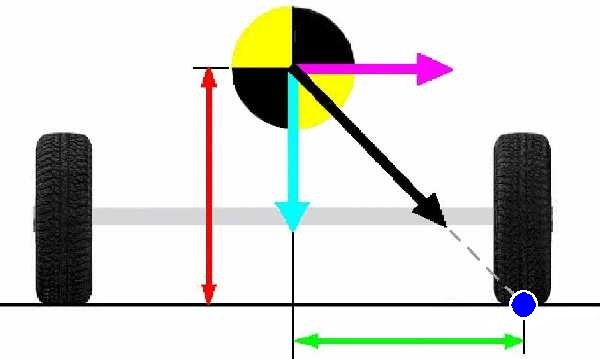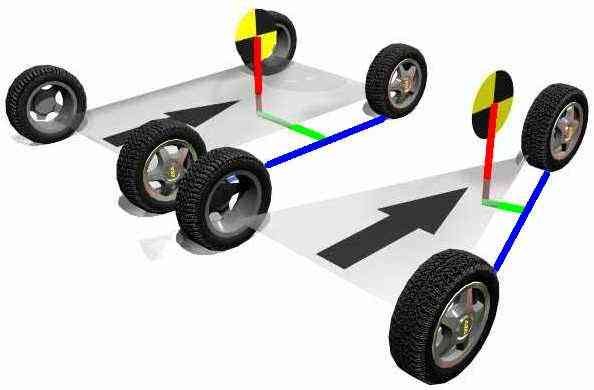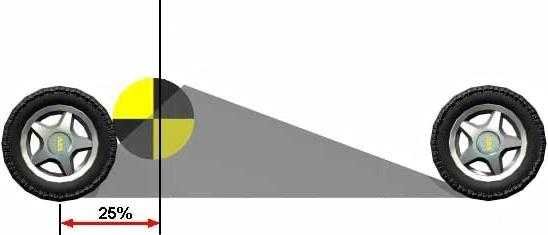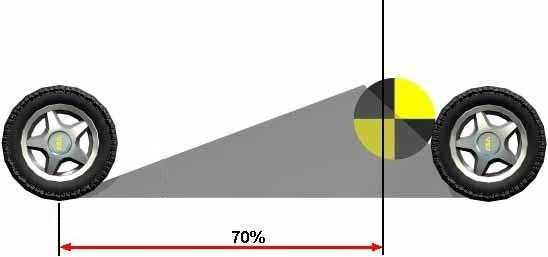Simple visual analysis of 3-Wheeler stability:

A) Center of gravity position:
Consider first a 4-Wheeler as seen from the rear, like here to the right. If the vehicle is in a curve towards the left, for example, we can imagine that a centrifugal force (magenta color) is exerted on the center of gravity (black and yellow circle) of the vehicle-occupants system, while the vehicle’s weight exerts a downward gravitational force (cyan color).
Thus, the centrifugal force (magenta) tends to roll the vehicle over towards the right, around an imaginary point (deep blue) under the right tires, while the gravitational force (cyan) holds the vehicle back to avoid rollover.
It’s as though the centrifugal force and the gravitational force combined together into a resulting force (black) exerted on the center of gravity to turn it around this imaginary point (deep blue).
We can thus easily understand that if the center of gravity height (red) is greater than the half-track (green) (the half distance between the two wheels seen from the rear), the resulting force (black) will be aligned over the imaginary point (deep blue) and will thus roll the vehicle over in a curve.

The ratio of the center of gravity height (red) to this half-track (green) thus plays a crucial role in determining the stability against rollover of a 4-Wheeler. Ideally, this center of gravity height (red) should be low like for a sports car, in order to insure a safety margin against rollover. In the case of ‘sport-utility’ 4X4s, this height is relatively larger than for regular family cars. This explains why these vehicles often have a higher rollover propensity.
In the case of 3-Wheelers, another factor comes into play:
As can be seen for a 4-Wheeler on the illustration at the right, the 4-Wheeler rolls over around a line (deep blue) corresponding to the imaginary point (deep blue) of the previous illustration.
But in the case of a 3-Wheeler, the vehicle rather rolls over around a line (deep blue) going from the unique wheel to one of the two symmetrical wheels. We can immediately see that the green line between the center of gravity and the rollover line is thus shorter than in the case of the 4-Wheeler, even though the center of gravity height, the length and the track of the 3-Wheeler are the same as those of the 4-Wheeler.
The center of gravity height (red) is thus proportionately greater, which reduces the safety margin against rollover in curves.
Moreover, a 3-Wheeler in a curve can also be subject to a braking or accelerating force that will combine with the lateral centrifugal force, which may further increase chances of rolling over of this 3-Wheeler. For example in the case of the single-front-wheel 3-Wheeler, here above to the right, braking in a curve towards the left will increase chances of rolling over this 3-Wheeler.
So in the case of a 3-Wheeler:
– The center of gravity height should be low in relation to the half-track, like for a 4-Wheeler.
– But the center of gravity’s position also has importance: The farther it is from the two symmetric wheels towards the single wheel, the shorter is the distance (the green line) from the center of gravity to the rollover line, which reduces the safety margin against rollover of the 3-Wheeler compared to the 4-Wheeler.
.
B) Accelerating or braking in a straight line:

When going straight, a 3-Wheeler may be accelerating or braking. Thus:
– It may tip backward while accelerating, as in the case of a two-rear-wheels 3-Wheeler where the center of gravity is located too far back,
– Or, while braking in the case of a two-front-wheels 3-Wheeler illustrated at the right, it may roll around the blue point under the front wheels and tip forward.

Summarizing, the 3-Wheeler’s center of gravity must be low and close to the two symmetrical wheels, that are alone to avoid a rollover in curves.
But this center of gravity must not be too close to these two symmetric wheels, to avoid tipping backward or forward.
Basically, the center of gravity must be located under a pyramid, as shown to the right in the case of a two-front-wheel 3-Wheeler, to avoid rolling over sideways or tipping forward.
.
.
C) Canadian Motor Vehicle Safety Regulations – CMVSS 505 Vehicle Stability:
These Canadian Motor Vehicle Safety Regulations (You have to go down to 505 and click on Vehicle Stability) stipulate in CMVSS 505 standard that:
“… the height of the center of mass, shown in Figure 1, of a motor tricycle or a three-wheeled vehicle shall not exceed one and a half times the horizontal distance from the center of mass to the nearest roll axis, shown in Figure 2.

So according to this regulation, the center of gravity height (in red) may thus be one and a half times the green line between the center of gravity and the rollover line, as illustrated at the right. The resulting force (black) may thus be aligned over the imaginary point (deep blue) and roll the vehicle over in a curve.
Obviously, this regulation is very large and more appropriately too large, since it may permit certain insufficiently stable vehicles to circulate on public roads.
As a counter part, this regulation has the merit of bringing order to the world of two and three wheel motorcycle definitions and regulations. Also, one could argue that with such an easy regulation, there are less chances of killing the touring motorcycle aftermarket, where goodwill manufacturers can continue replacing single rear wheels by two rear wheels, on motorcycles used by goodwill people that use them carefully and do not ride fast.
This Canadian regulation also stipulates in article 505, that:
“The total weight of a motor tricycle or three-wheeled vehicle on all its front wheels, as measured at the tire-ground interfaces, shall be not less than 25 per cent and not greater than 70 per cent of the loaded weight of that vehicle.”

The image at the right illustrates the case of a single-front-wheel 3-Wheeler having its vehicle-occupants center of gravity located at less than 25% of the wheelbase length from the rear wheels. This leaves less than 25% of the weight on the front wheel.
.
.
The image below illustrates the case of a two-front-wheels 3-Wheeler having its vehicle-occupants center of gravity located at more than 70% of the wheelbase length from the rear wheel. This leaves more than 70% of the weight on the front wheel.

.
Even though this regulation may bring order to motorcycle definitions and regulations, it’s nonetheless peculiar that:
– There is no obvious ‘mechanical’ reason to treat differently these two types of 3-Wheeler: The first could ‘merit’ 30% of the weight on its unique front wheel (instead of 25%). Or the second could ‘merit’ 75% of the weight on its two front wheels (instead of 70%).
– In each of these two cases illustrated above, the vehicle-occupants center of gravity is located below or at the limit of the pyramid, so that the single-front-wheel will not flip backwards when accelerating and the two-front-wheel will not tip forward when braking.
Summarizing, there is no reason to treat differently the risk of overturning laterally (rolling)
and the risk of flipping backwards or tipping forward.
In all cases, it seams more appropriate to:
– Consider overturning, flipping or tipping points or axes.
– And insure an adequate ratio between the vehicle-occupants center of gravity height and the horizontal distance between the center of gravity and these points or axes, or insure to be under the stability pyramid.
